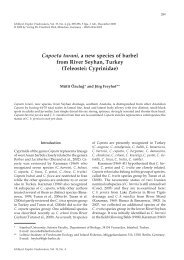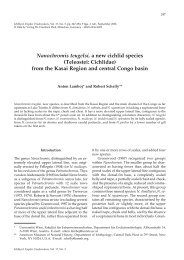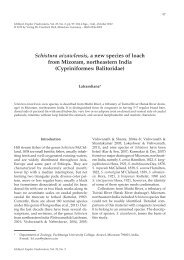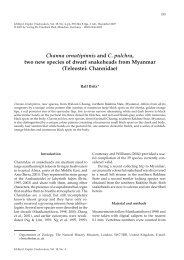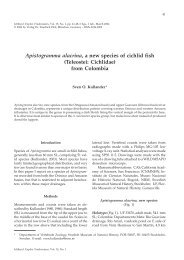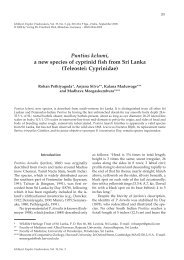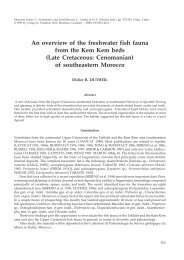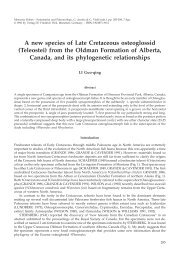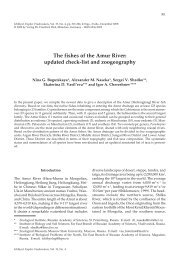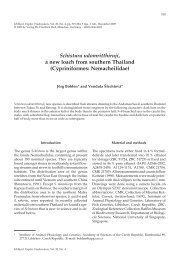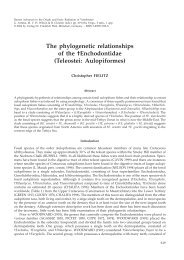A synopsis of the South Asian fishes referred to Puntius - Verlag Dr ...
A synopsis of the South Asian fishes referred to Puntius - Verlag Dr ...
A synopsis of the South Asian fishes referred to Puntius - Verlag Dr ...
Create successful ePaper yourself
Turn your PDF publications into a flip-book with our unique Google optimized e-Paper software.
70<br />
47 lateral-line scales; a complete, incomplete or<br />
interrupted lateral line; none, one or two pairs <strong>of</strong><br />
barbels; a weak or strong, serrated or smooth last<br />
unbranched dorsal-fin ray; and a body coloration<br />
composed <strong>of</strong> a spot or blotch at <strong>the</strong> base <strong>of</strong> <strong>the</strong><br />
caudal fin, one or more blotches or bars on <strong>the</strong><br />
body, one or more lateral stripes, or none at all<br />
(Jayaram, 1991). The genus comprised 48 valid<br />
species in <strong>the</strong> <strong>South</strong> <strong>Asian</strong> region as at 1990 (Talwar<br />
& Jhingran, 1991), since when some 30 additional<br />
species have been described.<br />
The first experimental investigation <strong>of</strong> species<br />
groups within <strong>Puntius</strong> appears <strong>to</strong> have been by<br />
Kortmulder (1972). As a result <strong>of</strong> similarities<br />
between <strong>the</strong>ir larvae and juveniles, and through<br />
a number <strong>of</strong> hybridization experiments, he suggested<br />
close relationships between P. filamen<strong>to</strong>sus<br />
and P. arulius; and between P. s<strong>to</strong>liczkanus, P. conchonius,<br />
P. phutunio, P. cumingii and P. nigr<strong>of</strong>asciatus,<br />
concluding that “cumingii, phutunio and gelius<br />
are more or less neotenous descendants from a<br />
nigr<strong>of</strong>asciatus like ances<strong>to</strong>r.” A single experiment<br />
he performed <strong>to</strong> hybridize P. conchonius and<br />
P. filamen<strong>to</strong>sus, however, produced larvae that<br />
died shortly after hatching as a result <strong>of</strong> being<br />
unable <strong>to</strong> aerate <strong>the</strong>ir swim bladders, suggestive<br />
<strong>of</strong> <strong>the</strong>ir belonging <strong>to</strong> different sub-groups within<br />
<strong>Puntius</strong>.<br />
Following on this Taki et al. (1978), from an<br />
osteological study <strong>of</strong> 23 mostly Sou<strong>the</strong>ast <strong>Asian</strong><br />
species <strong>of</strong> <strong>Puntius</strong> s.l., proposed six groups, <strong>of</strong><br />
which two (<strong>the</strong>ir P. conchonius group and <strong>the</strong><br />
P. arulius group) comprised <strong>South</strong> <strong>Asian</strong> species.<br />
In a later study, Shantakumar & Vishwanath<br />
(2006) included also P. sophore, <strong>the</strong> type species<br />
<strong>of</strong> <strong>Puntius</strong>, and showed that this species, <strong>to</strong>ge<strong>the</strong>r<br />
with P. terio and P. chola, possesses a postepiphysial<br />
fontanelle and a smooth, weak last<br />
unbranched dorsal-fin ray. Both <strong>the</strong>se characters<br />
were absent in <strong>the</strong> o<strong>the</strong>r nine species <strong>of</strong> <strong>Puntius</strong><br />
s.l. <strong>the</strong>y examined, which included two members<br />
<strong>of</strong> <strong>the</strong> P. conchonius group <strong>of</strong> Taki et al. (1978).<br />
They also proposed a group not sampled by <strong>the</strong><br />
previous authors, comprising P. sarana, P. jayarami<br />
and P. orphoides, which differed from <strong>Puntius</strong><br />
s. s. and <strong>the</strong> P. conchonius group by possessing<br />
35-36 (vs. 29-33) vertebrae and a free uroneural<br />
(absent in <strong>Puntius</strong> s. s. and <strong>the</strong> P. conchonius<br />
group).<br />
The foregoing work suggests that <strong>Puntius</strong> s. l.<br />
comprises a number <strong>of</strong> species groups that share<br />
various combinations <strong>of</strong> apomorphic characters<br />
and character states. The vast range <strong>of</strong> <strong>the</strong> genus<br />
(all <strong>of</strong> tropical <strong>South</strong> and Sou<strong>the</strong>ast Asia), and <strong>the</strong><br />
large number <strong>of</strong> included species, has made <strong>the</strong><br />
resolution <strong>of</strong> all <strong>the</strong> species groups <strong>of</strong> which<br />
<strong>Puntius</strong> is presently composed a challenge. The<br />
conservative body plan <strong>of</strong> <strong>the</strong> included species<br />
<strong>to</strong>o, has resulted in analyses <strong>of</strong> external morphology<br />
alone (e. g. Pillay, 1951; Jayaram, 1991; De<br />
Silva & Liyanage, 2010) proving <strong>to</strong> be <strong>of</strong> limited<br />
value in identifying species groups. At <strong>the</strong> same<br />
time, given <strong>the</strong> steady accretion <strong>of</strong> new species<br />
<strong>to</strong> <strong>Puntius</strong> s. l., especially from <strong>South</strong> Asia, an<br />
improved understanding <strong>of</strong> <strong>the</strong> species-groups<br />
that comprise it is desirable. Here, based on an<br />
analysis <strong>of</strong> external morphology and osteology,<br />
and a molecular phylogeny constructed from a<br />
mi<strong>to</strong>chondrial 16S ribosomal RNA gene fragment<br />
(~ 540 bp) and a cy<strong>to</strong>chrome b gene fragment<br />
(~ 550 bp) including 30 putative species <strong>of</strong> Indian<br />
and Sri Lankan <strong>Puntius</strong> s. l., we show that at least<br />
five lineages are present within <strong>South</strong> <strong>Asian</strong><br />
<strong>Puntius</strong>, which we recognize as distinct genera.<br />
Material and methods<br />
Specimens <strong>referred</strong> <strong>to</strong> in this study are deposited<br />
in <strong>the</strong> Australian Museum, Sydney (AMS); <strong>the</strong><br />
Natural His<strong>to</strong>ry Museum, London (BMNH); <strong>the</strong><br />
Collection <strong>of</strong> Maurice Kottelat, Cornol (CMK);<br />
<strong>the</strong> Raffles Museum <strong>of</strong> Biodiversity Research,<br />
Singapore (ZRC); <strong>the</strong> collection <strong>of</strong> <strong>the</strong> Wildlife<br />
Heritage Trust <strong>of</strong> Sri Lanka (WHT), now deposited<br />
in <strong>the</strong> National Museum <strong>of</strong> Sri Lanka, Colombo<br />
(NMSL); and <strong>the</strong> Zoological Survey <strong>of</strong><br />
India, Kolkata (ZSI). Abbreviations: SL, standard<br />
length; HL, head length.<br />
Measurements were made with digital Vernier<br />
calipers and recorded <strong>to</strong> <strong>the</strong> nearest 0.05 mm.<br />
<strong>Dr</strong>awings were made using a Motic dissecting<br />
microscope fitted with a camera lucida. Methods<br />
for taking counts and measurements follow<br />
Pethiyagoda & Kottelat (2005a), except that scales<br />
in transverse line on body were counted downwards<br />
and backwards from dorsal-fin origin <strong>to</strong><br />
<strong>the</strong> pelvic-fin origin. Osteological descriptions are<br />
based on alizarin-stained specimens (2 from each<br />
species, following <strong>the</strong> method <strong>of</strong> Taylor & Van<br />
Dyke, 1985) and/or x-ray radiographs. Osteological<br />
nomenclature follows Conway (2011).<br />
Numbers in (square) brackets following a count<br />
indicate <strong>the</strong> frequency <strong>of</strong> that count.<br />
Pethiyagoda et al.: Synopsis <strong>of</strong> <strong>South</strong> <strong>Asian</strong> <strong>Puntius</strong>




